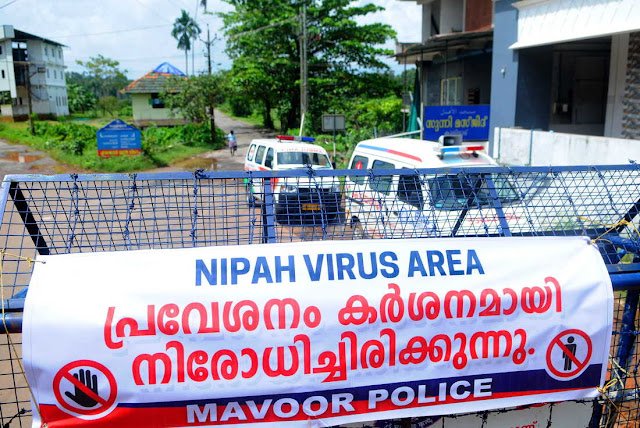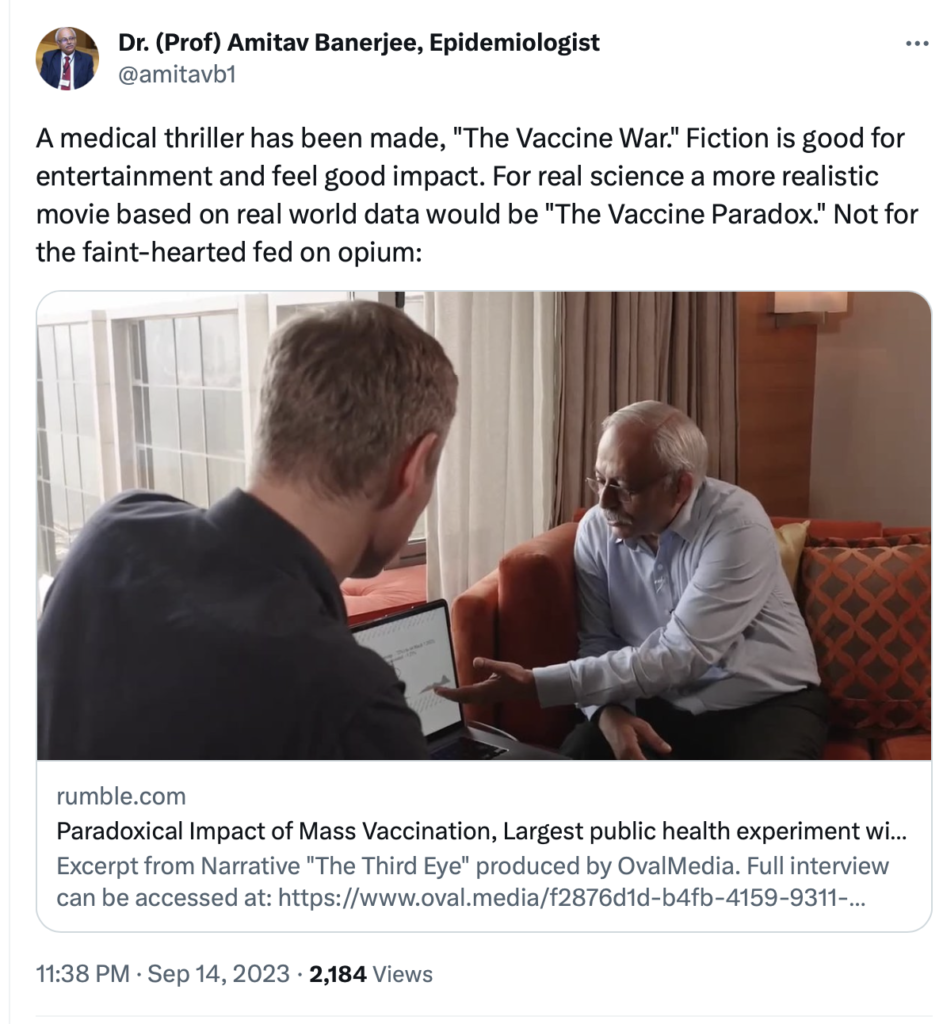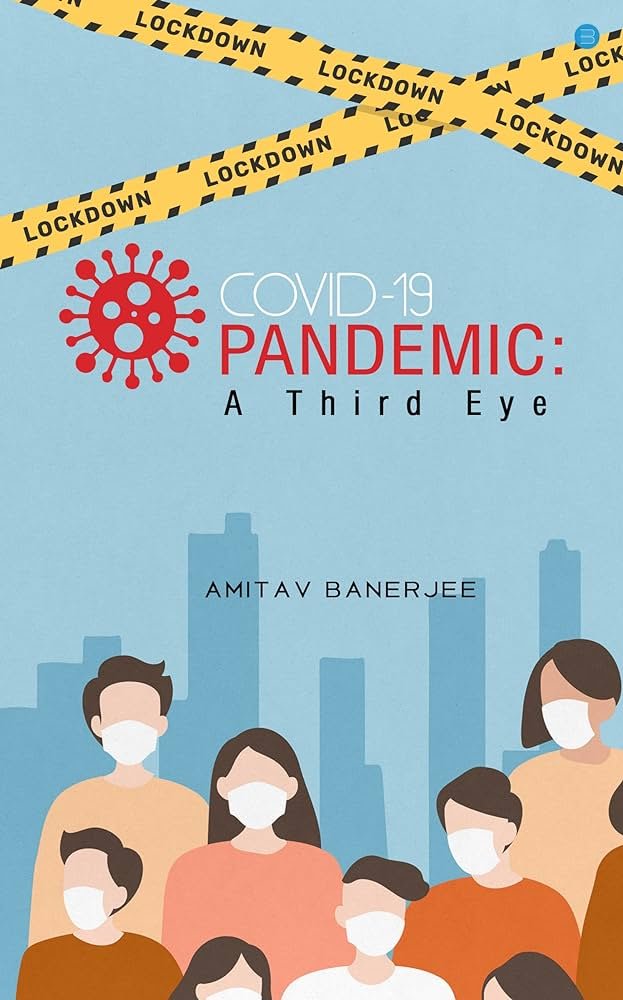
By Dr. (Prof) Amitav Banerjee, Epidemiologist
Universal Health Organisation (UHO), Chairman
Postdoctoral in epidemiology, who was a field epidemiologist for over two decades in the Indian Armed Forces. He also led the mobile epidemic investigation team at the Armed Forces Medical College, Pune, India from 2000 to 2004. During this period he investigated a number of outbreaks in different parts of the country. He was awarded for his work on Tribal Malaria and Viral Hepatitis E. He presently is a Professor in a Medical College in Pune

Some critics have commented that the ecstatic response of most Indians to the Oscar for the racy Indian song, “Naatu-Naatu” from the film, “RRR” reeks of sheer racism, insulting visuals and a colonial hangover. It was perhaps these ingredients that impressed the Academy of Motion Picture Arts and Sciences, one critic says.
“Naatu-Naatu” isn’t just another peppy Indian movie song with colourful sets. If it were so it wouldn’t have fetched an Oscar the critic concludes. Instead, the song depicts a demeaning and dystopian colonial setting in which two of dark-skinned Indians are desperately trying to impress at an all-white English cocktail party. The five minute song conveys on how the West-admiring Indians obsequiously try to impress their Western counterparts.
( https://empirediaries.com/2023/03/14/naatu-naatu-oscar-best-song/ )
As an epidemiologist and public health expert for over four decades, I am dismayed to see this obsequiousness among our public health experts, scientists, policy makers and politicians in matters concerning health of our people. This attitude generates greater acts of omissions and commissions than commercial movies. At stake are lives and livelihoods of Indians.
CLICK HERE Present day scientists seek celebrity status at par with movie stars. When Nipah last emerged in Kerala, in 2018, scientists and policy makers claimed they controlled the virus by their efforts. Local film makers and musicians even made a celebratory music video out of it! This was perhaps a sign of things to come in the future. ( https://www.npr.org/sections/goatsandsoda/2018/07/01/622618912/india-beat-one-of-the-worlds-deadliest-viruses-and-made-a-music-video-about-it ) We have entered an era of commercial movies instead of serious science on matter of health and disease glossing over uncomfortable truths. Of course now we have a full fledged blockbuster on the Covid-19 pandemic –”The Vaccine War,” which celebrates “Made in India” Covaxin for Covid-19, a vaccine which was hardly used in India, with only 16% Indians taking this vaccine. The Vaccine War: https://www.imdb.com/title/tt23554840/ 16%: https://en.wikipedia.org/wiki/COVID-19_vaccination_in_India There was nothing “Made in India” about Covidshield except for cheap Indian labour scaling up the production of a vaccine which was rejected by the West. Nothing to cheer about a “Lost Vaccine War” as our “India Made” Covaxin’s contribution to our vaccine rollout was a mere 16% compared to 80% by the British-Swedish Pharma giant Astrazeneca vaccine marketed as Covishield. Fiction and glamour overtake serious science. And of course career scientists who now have the incentive to become celebrities overnight in addition to promoting their careers. Let us examine the science of the Nipah virus sans the glamour of movies and music videos. The virus crossed the animal barrier from bats and infected humans resulting in encephalitis (inflammation of the brain) with up to 40% mortality. The outbreak was first recognized in pigs that consumed fruits partially eaten by the fruit bats and transmitted the infection to humans. (https://www.ncbi.nlm.nih.gov/pmc/articles/PMC10413696/pdf/41182_2023_Article_535.pdf) In India the first outbreak of Nipah occurred in Nadia in West Bengal in the year 2007. Then in 2018, Nipah outbreak was reported in Kozhikode, Kerala with fruit bats as the source of the infection. During this outbreak most deaths occurred among health care workers in close contact with infected patients. A total of 60 infected people died. Another outbreak occurred in 2021 in Kerala and since then Nipah had claimed 20 lives and is reported to be spreading in Kerala. However, there is again hype of an emerging pandemic on occurrence of two deaths due to the Nipah virus in Kerala in the past few weeks. Only a handful of people have been found to be infected on contact tracing involving thousands of people. We have entered an era of commercial movies instead of serious science on matter of health and disease glossing over uncomfortable truths This can be achieved in several ways. Social media platform and local television channels are important platforms for proper risk communication without causing panic. Others include FM radio stations and local newspapers and posters. Farm workers may be informed to avoid direct contact with farm animals, especially during slaughter and disposal, wearing appropriate personal protective clothing during hazardous tasks. Villagers may be told to avoid eating date palm fruits and drinking date palm juice that may be contaminated if fruit bats live on these palm trees. These are similar to the simple measures we teach to avoid getting killed in road traffic accidents. We educate the public to follow traffic rules. In vain it seems in our country, and the police too is casual in penalising defaulters unlike the gusto they display in enforcing draconian measures like mask mandates and lockdowns! If media hypes each case of road traffic accident occurring on a daily basis, people can be psyched to stop using motorized transport and stepping out as well. Imagine, and get the perspective – every day in India we lose more lives than the total lives lost due to Nipah virus in 24 years! It would save more lives if the policy maker and police came down more heavily on traffic rules violations than close schools and businesses due to viruses and pathogens which abound in nature and are not amenable to control by such unscientific interventions. Stray dogs still abound on Indian streets with frequent news report of a child or an elderly( https://www.thehindu.com/news/national/andhra-pradesh/elderly-mans-body-found-mauled-by-stray-dogs-in-andhra-pradesh/article66698875.ece ) being mauled ( https://www.indiatoday.in/india/story/stray-dog-bite-child-dies-in-dog-attack-gujarat-morbi-2405793-2023-07-13 ) by them. How callous can our policy makers be – neglecting these obvious public health menaces and chasing an exotic virus with far less deaths at the population level! The lab was being used without approval of the government of India to map the Nipah virus which can be used to develop the vaccine, the intellectual propriety rights of which will not be with India. Studying how the human host reacts to the virus can also potentially help in the notorious, “gain of function” research. Additional Information: Dr. Amitav Banerjee on Twitter: Robert Cibis discusses with him the effects of the anti-COVID19 injections on the number of infections. For countries like Sri Lanka or Indonesia, there are massively negative findings, as the professor explains in his most recent study. This impression is reinforced by the fact that there were hardly any infected people before the time of injections. This is a bombshell for the dominant narrative. What do we do with it? The book “The Third Eye” by Prof. Dr. Amitav Banerjee https://translate.google.com/website?sl=auto&tl=en&hl=en&u=https://bookrelease.wordpress.com/2022/03/19/interview-with-amitav-banerjee/ The last study by Prof. Dr. Amitav Banerjee https://translate.google.com/website?sl=auto&tl=en&hl=en&u=https://www.mjdrdypv.org/article.asp?issn%3D2589-8302;year%3D2022;volume%3D15;issue%3D3;spage%3D293;epage%3D298;aulast%3DBanerjee;type%3D3 Source: counterview Also Read:
Around 80% Indians were administered Covidshield which was developed by Astrazeneca in UK and Serum Institute of India was the sweatshop ( https://economictimes.indiatimes.com/industry/healthcare/biotech/pharmaceuticals/tie-up-with-serum-institute-of-india-key-to-mass-production-of-covid-vaccines-say-two-pharma-majors/articleshow/81202007.cms?from=mdr ) for mass production of the Covishield brand. A large number of countries had halted ( https://apnews.com/article/germany-suspends-astrazeneca-vaccine-blood-clotting-0ab2c4fe13370c96c873e896387eb92f ) the rollout of Astrazeneca/Covishield due to Adverse Events Following Immunization (AEFI).
One who pays the piper calls the tunes. Western pharma giants find a vast market as well as cheap labour in India to scale up their sales and manufacturing.
The latest revived tune is “Nipah-Nipah.” We should not take any emerging or re-emerging infection lightly. Making movies and musical videos are not serious science. More pipers enter the fray. In addition to pharma giants and well meaning philanthropists with amateurish scientific insights, movie moguls eye the box office profits.
Nipah virus is a zoonosis, i.e. primarily an infection of animals. Humans can get accidently infected. The reservoir (where the virus thrives) is the fruit bat also called flying fox. Some of them may even enter human dwellings. Some fruit bats are even consumed as bushmeat by some communities. The virus was named after the village in Malaysia where it was first identified in 1999.
In the same year, Nipah virus infection was confirmed in 11 male abattoir workers in Singapore out of which 1 died. His death was suspected to be due to handling imported pork from Malaysia. The outbreak ( https://pubmed.ncbi.nlm.nih.gov/19108397/#:~:text=The%20Nipah%20virus%20outbreak%20in%20Malaysia%20(September%201998%20to%20May,%2Ddollar%20pig%2Dfarming%20industry ) in 1998-99 in Malaysia and Singapore resulted in 265 cases of acute encephalitis with 105 deaths and near collapse of the billion dollar pig-farm industry.
In 2004 Bangladesh confirmed its first Nipah outbreak by the presence of anti-Nipah virus antibodies in serum samples. Between the years 2004-2010, Bangladesh had nine outbreaks and another one in 2011 in a remote village in which 15 people died. In Bangladesh, the main source of transmission was eating raw date palm fruits.
Nipah virus infection in human has a range of clinical presentation ( https://www.ncbi.nlm.nih.gov/pmc/articles/PMC10413696/pdf/41182_2023_Article_535.pdf ) from asymptomatic infection to acute respiratory infections, fatal encephalitis (brain inflammation), and severe neurological disease. The death rate is 40-75% according to reported outbreaks since 1998.
The high fatality rates is inversely related to its epidemic or pandemic potential as higher fatality translates to lesser transmission potential as reflected by R0. The R0 of the Nipah virus is less than 1 i.e. one infected person will transmit the infection to less than 1 person. Infections with R0 greater than 1 have higher chances to cause epidemics and pandemics. Nipah presently does not show that potential.
Ham-handed restrictive and draconian measures have become the protocol for all infections post Covid-19 pandemic. Studies have established that these crude unscientific measures caused more collateral harm ( https://www.ncbi.nlm.nih.gov/pmc/articles/PMC8396380/ ) with negligible benefit particularly in poor countries. Going against this evidence base, thousands of offices and schools have been closed in Kerala and containment zones ( https://frontline.thehindu.com/news/deadly-nipah-virus-break-out-in-kerala-what-are-the-symptoms/article67316127.ece#:~:text=Some%20patients%20experience%20respiratory%20problems,disease%20is%2070%20per%20cent ) have been established around nine villages. Such measures fracture society and are uncalled for. More rational would be preventive measures at individual level by proper awareness among the masses.
Daily around 422 people mostly young die due to road traffic accidents in India ( https://morth.nic.in/sites/default/files/RA_2021_Compressed.pdf ) and many more get disabled for life. This is perhaps more than all the deaths due to Nipah virus since it was discovered in 1999 in Malaysia, almost 24 years ago!
Even as infections go, over 1400 Indians succumb to TB daily, and dengue kills more in a year than Nipah has killed in 24 years just to give a couple of examples as data is not robust for communicable diseases that kill many time more than exotic infections. For example data on dengue is not current on the Ministry of Health and Family Welfare website ( https://ncvbdc.mohfw.gov.in/index4.php?lang=1&level=0&linkid=431&lid=3715 ). The latest figures are till 31 July 2023 and that too provisional.
We lose over 2,000 children daily from mundane preventable causes. Japanese encephalitis and Leptospirosis kill many times more than the sporadic Nipah and so on. A far deadlier zoonosis than Nipah, rabies with 100% mortality killed ( https://timesofindia.indiatimes.com/city/agra/307-died-of-rabies-in-india-last-yr-max-48-in-del-data-tabled-in-parl/articleshow/102155300.cms?from=mdr ) 307 people in India last year with 48 deaths in Delhi.
Scientists should continue their research activities in the background without clamouring for immediate media attention. Media hype distorts the information and creates public panic which can be counterproductive. Besides, pharma and the pharma backed WHO are desperately on the lookout for the next pandemic so as to push through the Pandemic Treaty which will give extraordinary autocratic powers to an unelected body and deprive democracies of their autonomy.
Regrettably similar to colonial times we are dancing to the tunes of the strong Western dominated pharma lobby and Western powers and Western “philanthropists” with deep pockets. Any death is a tragedy, Nipah or otherwise. But public health demands setting health priorities which depend on the burden of mortality and morbidity. Certainly, Nipah comes low down on this criterion. Trying to chase this at huge cost will divert resources from our other pressing public health problems.
The National Institute of Health (NIH), USA, has already launched clinical trials ( https://www.nih.gov/news-events/news-releases/nih-launches-clinical-trial-mrna-nipah-virus-vaccine ) of mRNA vaccines for Nipah virus. Some time back a private institute in South India, Manipal Centre for Virus Research, was surreptitiously collaborating ( https://www.hindustantimes.com/india-news/halt-nipah-project-with-indian-lab-govt-tells-us-health-agency/story-kRn55L1TJJKqUkUcsmXChK.html ) with the US based Centre for Disease Control (CDC) for research on Nipah virus which has also been identified as a potential bio-weapon.
History repeats itself. We have modern versions of Mir Jaffars who dance to the tunes of their Western masters, be it Naatu-Naatu or Nipah-Nipah!
Private institutions are under immense pressure as well as career scientists and academicians to get “foreign” grants for their research to advance in their institutional rankings and careers, respectively. Alas in this desperation they are liable to sell their souls if not their country to Western powers.

